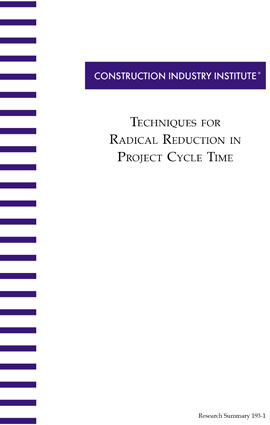
Techniques for Radical Reduction in Project Cycle Time
Radical reduction (a reduction of 25% or more in project cycle time compared to industry norms for similar projects) is achievable. Significant reductions, in the range of 25% to 50%, have been achieved on projects in a variety of industries. And, although not in the scope of this investigation, it is safe to assume that many more have failed. However, there is no simple formula or “silver bullet” to ensure this level of achievement.
To address radical reduction, the Construction Industry Institute (CII) established the Radical Reduction in Project Cycle Time Project Team (PT 193) to investigate the reality, requirements, and barriers to radical reduction in project cycle time. The goal of this research was to identify the common elements in the successful projects and attempt to provide an approach that would, to a greater degree, ensure the success of projects in true need of radical reduction in cycle time.
The research found several common themes in projects achieving radical reduction. These have been divided into drivers and techniques. The drivers identified must be present or employing the techniques will be of lesser value. Of the drivers, the owner’s commitment throughout the process is the key. This is the most consistent and determining factor in successful cycle time reduction. Once the commitment exists with a continuing need, then high performing teams backed with detailed planning and armed with proven reduction techniques can execute and deliver a project in significantly less time.
Of the successful techniques, none are new or unusual to the engineering and construction industry. Many are CII Best Practices. Others include management and schedule reduction techniques. This research explains which techniques consistently have the greatest influence and, equally important, when they are best applied.
While not totally surprising, the research found some collateral benefits on the projects studied. Safety did not deteriorate with the emphasis on schedule reduction, but in most cases it improved. Quality did not suffer, but again, in most cases improved. Finally, and probably somewhat unexpectedly, cost did not increase but decreased on most projects.
Several tools were developed to optimize the implementation of these techniques. Two implementation resources, Project Manager’s Game Planner (IR193-2) and Project Manager’s Playbook (IR193-3) are available from CII as a result of this research.
Radical reduction is not possible on every project. It takes a huge commitment, a strong team, and outstanding execution. In some instances, the cycle time has already been significantly reduced over time through experience and less intense attempts at compression.
Teams and projects have accomplished radical reduction without previous experience in such achievements. If the drivers are in place, the techniques in this research are utilized, and the tools developed by this research are employed, radical reduction is within reach.
To achieve radical reduction in cycle time, four key drivers must be present, with owner commitment being the most critical: (RS193-1, p. 1)
- Why
- A compelling business need
- Owner commitment
- How
- A high performing team
- Detailed project planning and execution
The characteristics of the projects that showed the most promise for radical reduction in cycle time were as follows:
- Complex
- High degree of integration with outside stakeholders
- High degree of upper management support
- Large projects with high level of purchasing activities and multiple packages
- Projects with strong business drivers


